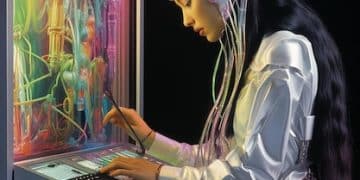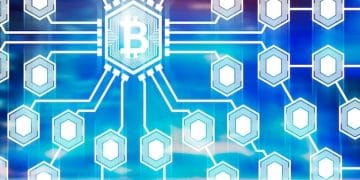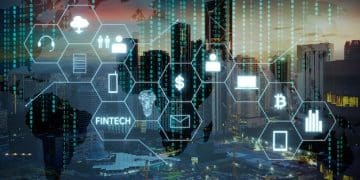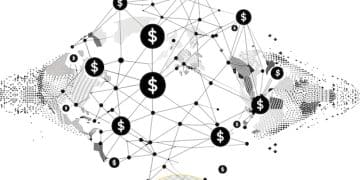Blockchain Gaming in the US: NFTs and Play-to-Earn Potential

Blockchain gaming in the US market leverages NFTs and play-to-earn models to create immersive and rewarding experiences for gamers, offering new opportunities for digital ownership and economic participation.
The fusion of blockchain technology and gaming has sparked a revolution, particularly in the US market, with **blockchain gaming: exploring the potential of NFTs and play-to-earn in the US market** at the forefront of this innovative trend.
Understanding Blockchain Gaming
Blockchain gaming represents a paradigm shift in the gaming industry, moving away from traditional models to incorporate decentralized technologies.
By leveraging blockchain, games can offer players true ownership of in-game assets, enhanced security, and new avenues for monetization.
What is Blockchain Gaming?
Blockchain gaming integrates blockchain technology into video games. This allows for the creation of unique, verifiable digital assets represented as NFTs (Non-Fungible Tokens) that players can own, trade, and use within the game.
- 🎮 NFT Integration: NFTs represent in-game items, characters, or virtual land, providing provable ownership.
- 💰 Play-to-Earn (P2E) Mechanics: Players earn cryptocurrency or NFTs through gameplay, creating economic incentives.
- 🔒 Decentralization: Blockchain ensures that game assets are not controlled by a central authority, enhancing security and transparency.
This integration fosters a more engaged and invested player base, driving the growth of blockchain gaming.
The Role of NFTs in Blockchain Games
NFTs are a cornerstone of blockchain gaming, enabling true digital ownership and creating new economic opportunities.
They revolutionize how players interact with and value in-game assets.
Benefits of NFTs in Gaming
NFTs provide numerous benefits to both players and developers within the blockchain gaming ecosystem.
These include:
- ✨ True Ownership: Players own their in-game assets, which can be freely traded on NFT marketplaces.
- 📈 Scarcity and Value: NFTs create scarcity, driving up the value of rare or unique items.
- 🤝 Interoperability: Some NFTs can be used across multiple games, increasing their utility.
NFTs empower players, giving them control over their digital assets and creating new revenue streams.

Play-to-Earn (P2E) Models Explained
Play-to-earn (P2E) is a revolutionary model that rewards players with real-world value for their in-game efforts.
This model is transforming the way people approach gaming, turning it into a potential source of income.
How P2E Works
P2E games reward players with cryptocurrency or NFTs for completing tasks, winning battles, or achieving milestones.
The earned assets can then be traded on exchanges or used within the game.
Examples of P2E mechanisms include:
- 🏆 Earning Cryptocurrency: Receiving tokens for completing quests or winning tournaments.
- 💎 Collecting and Selling NFTs: Obtaining rare in-game items that can be sold on marketplaces.
- 🗺️ Owning Virtual Land: Earning income from virtual properties.
P2E models incentivize active participation and create a sustainable gaming economy.
The US Market for Blockchain Gaming
The US market is a significant player in the blockchain gaming space, with a growing number of developers and players embracing this technology.
Several factors contribute to the rapid adoption of blockchain gaming in the United States.
Factors Driving Adoption
Multiple factors contribute to the surge in blockchain gaming adoption in the US.
These include:
- 💡 Technological Innovation: The US is a hub for technological innovation, with a strong interest in blockchain and NFTs.
- 🎮 Large Gaming Community: The US has a large and engaged gaming community, eager to explore new gaming experiences.
- 💰 Economic Opportunities: The play-to-earn model offers attractive economic opportunities for players.
The US market is poised for continued growth in the blockchain gaming sector.
Challenges and Opportunities
While blockchain gaming offers numerous opportunities, it also faces several challenges that need to be addressed for widespread adoption.
Navigating these challenges will be crucial for the future of blockchain gaming.
Key Challenges
Several challenges hinder the widespread adoption of blockchain gaming:
- ⚖️ Regulatory Uncertainty: The legal and regulatory landscape for blockchain and cryptocurrencies remains unclear in many jurisdictions.
- 🛡️ Security Risks: Blockchain games are vulnerable to hacking and fraud, requiring robust security measures.
- 🌍 Scalability Issues: Blockchain networks can face scalability issues, impacting game performance.
Overcoming these challenges is essential for the sustained growth of blockchain gaming.

Future Trends in Blockchain Gaming
The future of blockchain gaming is full of exciting possibilities, with several emerging trends set to shape the industry.
Staying ahead of these trends will be crucial for success in the blockchain gaming market.
Emerging Trends
Several emerging trends are expected to drive the future of blockchain gaming:
- 🌐 Metaverse Integration: Seamless integration of blockchain games into the metaverse, allowing players to move assets between virtual worlds.
- 📱 Mobile Gaming: Increased focus on mobile blockchain games, expanding accessibility and reach.
- 🎮 Enhanced Graphics and Gameplay: Development of more visually appealing and engaging blockchain games.
These trends promise to revolutionize the gaming experience and unlock new opportunities for players and developers.
| Key Point | Brief Description |
|---|---|
| 🎮 NFTs in Gaming | NFTs enable true ownership of in-game assets. |
| 💰 Play-to-Earn | Players earn rewards with real-world value. |
| 🔒 US Market | Growing adoption driven by innovation and gaming culture. |
| 🚀 Future Trends | Metaverse integration and mobile gaming expansion. |
Frequently Asked Questions
A blockchain game is a video game that incorporates blockchain technology, typically using NFTs and cryptocurrencies. This allows players to own and trade in-game assets, enhancing the gaming experience.
Play-to-earn (P2E) models reward players with crypto or NFTs for their in-game activities, such as completing quests or winning battles. These rewards can then be traded or used within the game.
NFTs in gaming provide true ownership of in-game assets, allowing players to buy, sell, and trade their items. This also creates scarcity and can increase the value of unique items.
Challenges include regulatory uncertainty, security risks (like hacking), and scalability issues. These need to be addressed for wider adoption of blockchain gaming.
Future trends include metaverse integration, more mobile blockchain games, and enhanced graphics and gameplay. These innovations promise to revolutionize the gaming landscape.
Conclusion
Blockchain gaming: exploring the potential of NFTs and play-to-earn in the US market is rapidly evolving, offering transformative opportunities for gamers. By embracing these innovations and addressing the existing challenges, the US market can lead the way in shaping the future of gaming.





